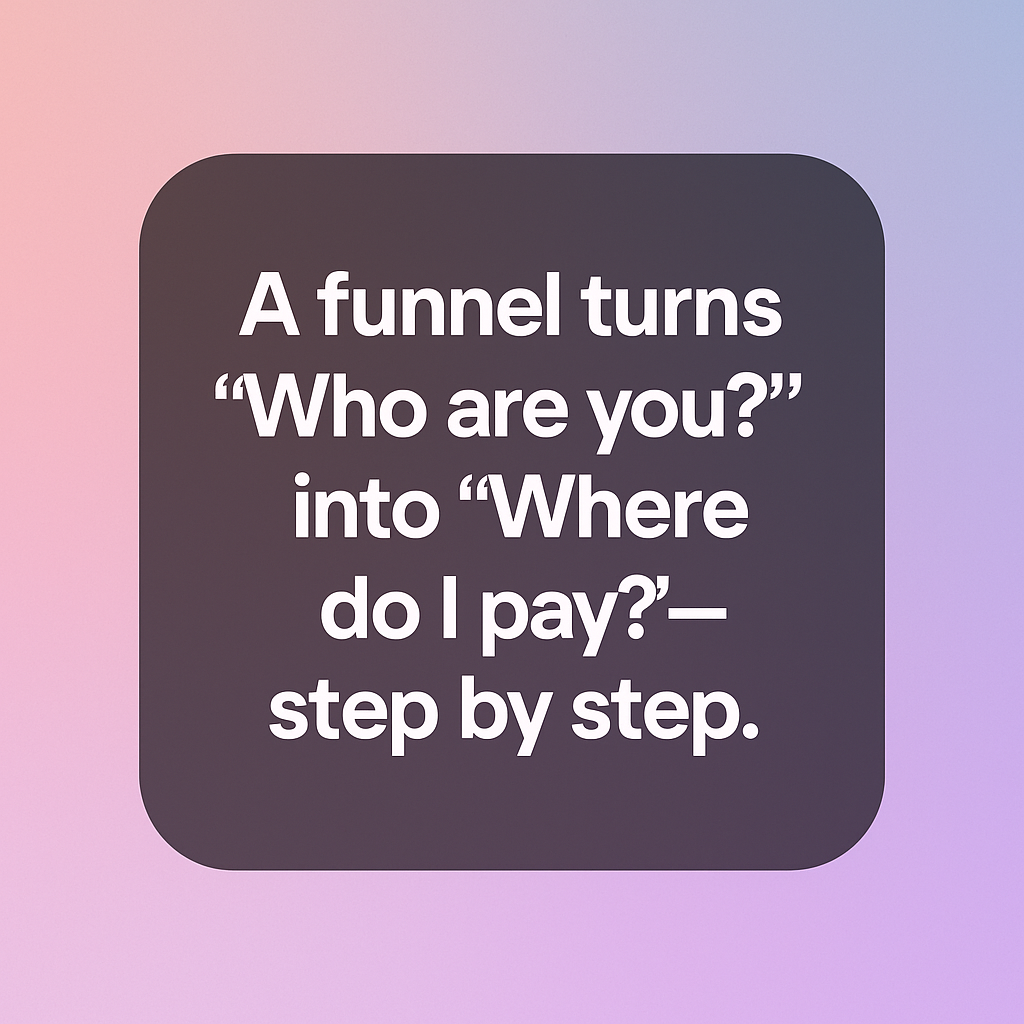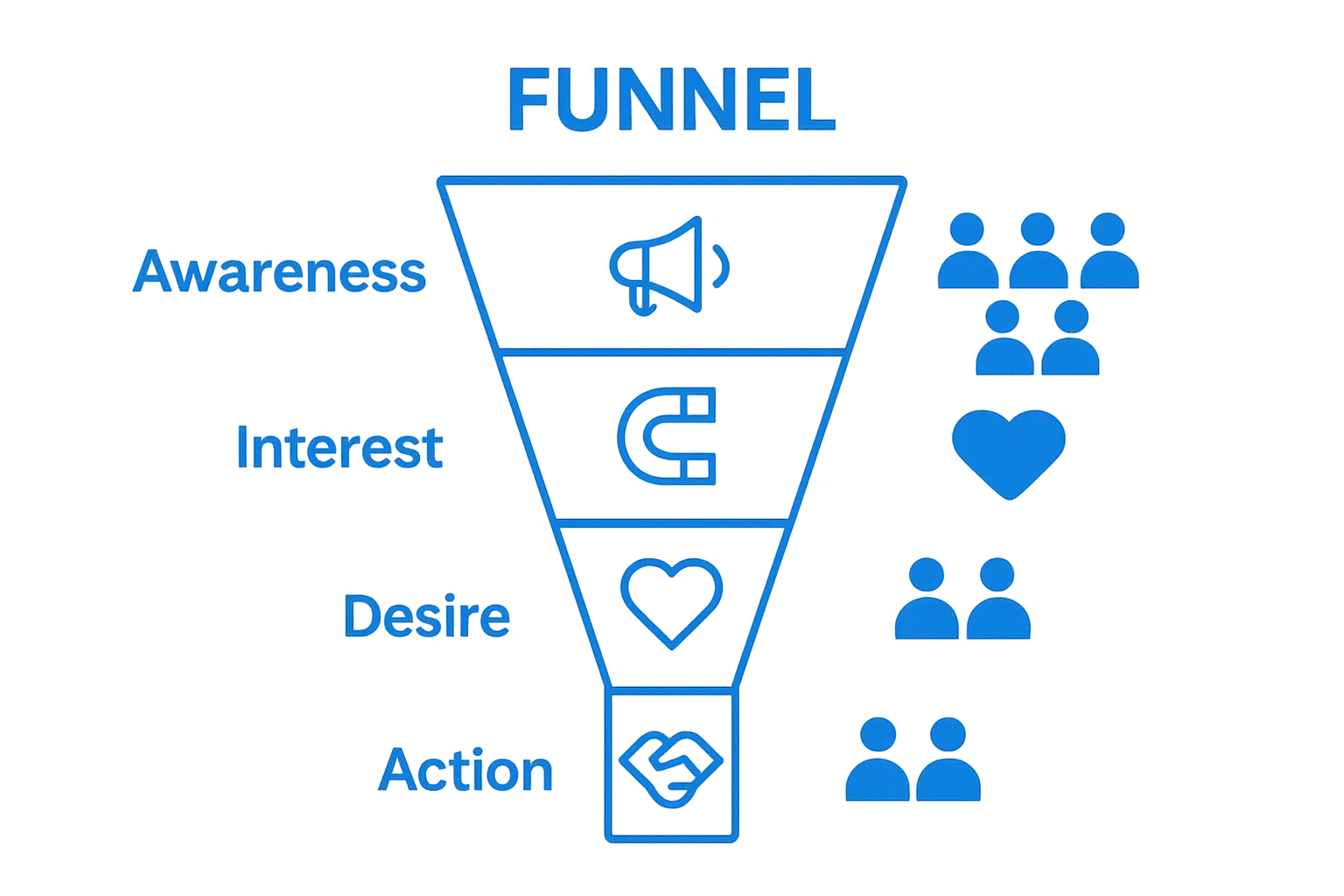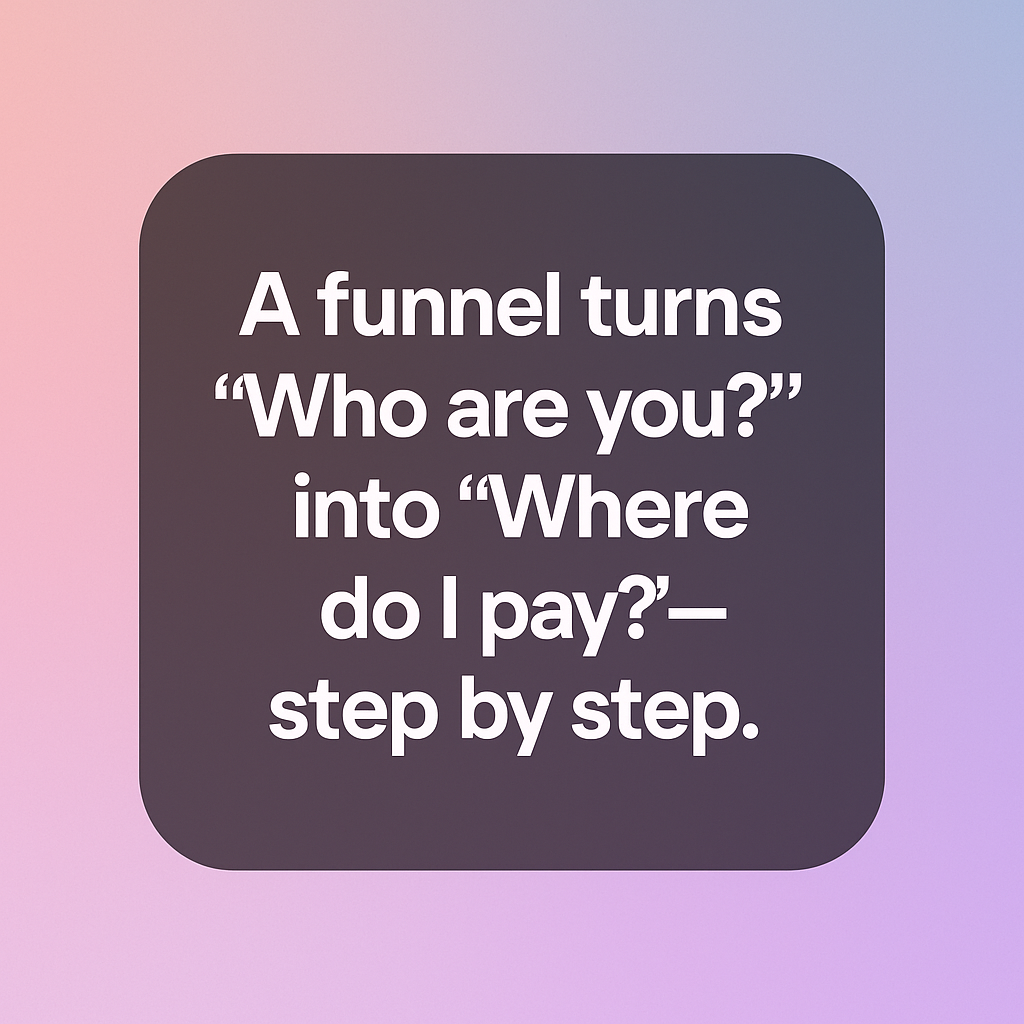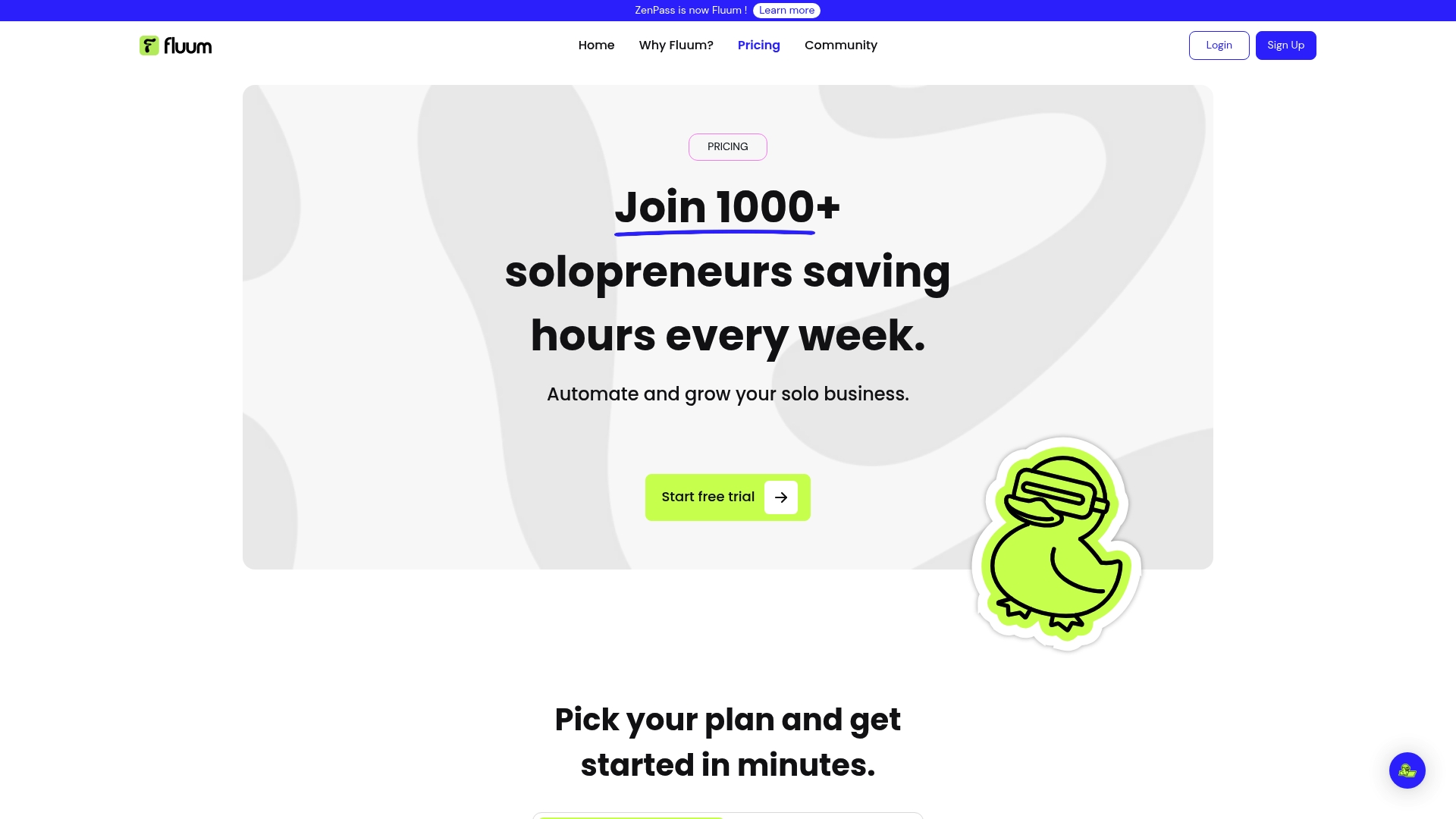
Everyone talks about building a sales funnel to win more clients. Yet most solo service providers miss how powerful it can really be. Businesses with well-structured sales funnels can see conversion rates rise by up to 300 percent. What most people overlook is how a simple funnel actually turns scattered leads into steady, reliable income that makes every day more predictable.
Table of Contents
- What Is A Sales Funnel And Its Importance
- The Stages Of A Sales Funnel Explained
- Why A Sales Funnel Matters For Your Business
- How A Sales Funnel Works In Real Life
- Key Concepts And Terms Related To Sales Funnels
Quick Summary
| Takeaway | Explanation |
|---|---|
| Understand sales funnel stages | Familiarize yourself with stages: Awareness, Interest, Desire, and Action to effectively engage potential clients. |
| Optimize marketing strategies | Use structured sales funnels to improve conversion rates and reduce wasted marketing efforts significantly. |
| Focus on client psychology | Tailor communication and value offerings based on understanding how clients make purchasing decisions. |
| Implement continuous tracking | Regularly analyze performance metrics to identify bottlenecks and optimize the sales process effectively. |
| Create strategic touchpoints | Design intentional customer interactions that guide prospects through a smooth decision-making journey. |
What is a Sales Funnel and Its Importance
A sales funnel represents a strategic marketing framework that visualizes the customer journey from initial awareness to final purchase. Unlike traditional linear sales approaches, a sales funnel acknowledges that potential customers move through different psychological stages before committing to a transaction. Our comprehensive guide on sales strategies can help you understand this concept more deeply.
Understanding the Conceptual Framework
At its core, a sales funnel illustrates how businesses attract, engage, and convert potential clients through a carefully designed process.
Think of it as an inverted pyramid where numerous potential customers enter at the wide top and progressively narrow down to a smaller group of committed buyers at the bottom. This visualization helps entrepreneurs and service providers map out precise strategies for guiding prospects through their decision making journey.
The fundamental stages of a sales funnel typically include:
- Awareness: Attracting potential customers and introducing them to your service or product
- Interest: Generating curiosity and demonstrating initial value
- Desire: Creating emotional connection and showing specific benefits
- Action: Motivating the final purchasing decision
Importance for Solo Service Providers
For solopreneurs and freelancers, understanding sales funnels becomes critically important. According to Forbes research on digital marketing strategies, businesses with well-structured sales funnels can improve conversion rates by up to 300%. By systematically guiding potential clients through each stage, service providers can:
- Reduce wasted marketing efforts
- Create more predictable revenue streams
- Build stronger connections with potential clients
- Optimize their overall business growth strategy
The sales funnel transforms random interactions into intentional, strategic customer acquisition, allowing solo professionals to work smarter rather than harder in their business development efforts.
The Stages of a Sales Funnel Explained
A sales funnel consists of multiple intricate stages designed to transform potential prospects into committed customers. These stages represent a psychological progression that mirrors how individuals make purchasing decisions. Learn more about advanced funnel strategies to enhance your understanding.
The Top of the Funnel: Awareness and Attraction
At the funnel’s widest point, potential customers first become aware of your services or solutions. According to Harvard Business Review research on consumer behavior, this initial stage involves creating visibility through strategic marketing channels. For solo service providers, awareness might involve:
- Social media content that highlights expertise
- Free valuable resources like webinars or guides
- Targeted online advertising
- Networking and professional collaborations
Middle of the Funnel: Engagement and Consideration
Once prospects recognize your value, they enter the middle section of the funnel. Here, potential clients evaluate whether your offering genuinely solves their specific problems. This stage requires demonstrating credibility through:
- Detailed case studies showcasing past successes
- Testimonials from satisfied clients
- Transparent pricing and service explanations
- Personalized communication addressing specific pain points
Bottom of the Funnel: Decision and Conversion
The final stage represents the narrowest part of the sales funnel, where interested prospects transform into actual paying clients. Successful conversion depends on removing potential barriers and creating irresistible value propositions. Strategic techniques at this stage include:
- Clear, low-risk initial offerings
- Straightforward purchasing processes
- Limited time incentives
- Comprehensive support and guarantee mechanisms
Understanding these nuanced stages helps solopreneurs design intentional customer journeys that naturally guide potential clients toward making confident purchasing decisions.
Below is a summary table of the main stages of a sales funnel, highlighting the purpose and key activities at each stage for solo service providers.
| Funnel Stage | Purpose | Key Activities and Tactics |
|---|---|---|
| Awareness | Attract new potential customers | Social posts, free resources, advertising, networking |
| Interest | Generate curiosity and demonstrate value | Case studies, testimonials, transparent explanations |
| Desire | Build an emotional connection and show benefits | Personalized communication, highlight results, address pain points |
| Action | Motivate final purchase decision | Low-risk offers, simple purchase process, incentives, support |

Why a Sales Funnel Matters for Your Business
A strategic sales funnel is not just a marketing concept but a critical business tool that transforms how solo service providers connect with potential clients. Explore our comprehensive guide to client funnel optimization to elevate your business approach.
Efficiency in Customer Acquisition
Sales funnels provide a systematic approach to understanding and guiding potential customer interactions. According to McKinsey research on business growth strategies, businesses with structured customer journeys can reduce acquisition costs by up to 50%. For solopreneurs, this translates into:
- Targeted marketing efforts
- Reduced time spent on unqualified leads
- More predictable revenue generation
- Strategic resource allocation
Psychological Alignment and Customer Understanding
Beyond numerical metrics, sales funnels offer profound insights into customer psychology. They help entrepreneurs map the emotional and rational decision making processes of their target audience. By understanding these nuanced stages, service providers can:
- Develop more empathetic communication strategies
- Create tailored value propositions
- Address potential objections proactively
- Build trust through strategic engagement
Measurable Growth and Continuous Improvement
The true power of a sales funnel lies in its ability to provide actionable data and insights. Systematic tracking allows solopreneurs to identify precisely where potential clients disengage and optimize their approach accordingly. Key benefits include:
- Precise conversion rate monitoring
- Identification of bottleneck stages
- Data driven decision making
- Continuous performance optimization
Implementing a well designed sales funnel transforms random business interactions into a structured, intentional growth strategy that consistently attracts and converts ideal clients.

How a Sales Funnel Works in Real Life
Real world sales funnels transform abstract marketing concepts into practical business strategies that solo service providers can implement immediately. Discover innovative funnel techniques to enhance your client acquisition process.
Practical Implementation for Service Professionals
In practical terms, a sales funnel operates like a carefully designed customer journey map. According to Nielsen Norman Group research on user experience, successful digital experiences require understanding sequential customer interactions. For solopreneurs, this means creating intentional touchpoints that guide potential clients through a seamless progression:
- Initial awareness through targeted content
- Low risk engagement opportunities
- Personalized interaction mechanisms
- Gradual trust building approaches
Converting Interest into Commitment
Effective sales funnels translate casual interest into genuine client relationships. Successful conversion happens through strategic psychological triggers that address potential client hesitations. Solo professionals achieve this by:
- Demonstrating specialized expertise
- Offering transparent value propositions
- Creating low barrier entry points
- Providing social proof and credibility indicators
Continuous Optimization and Adaptation
A dynamic sales funnel is never static but continuously evolves based on real world feedback and client interactions. Solopreneurs must remain agile, tracking performance metrics and adjusting their approach. Key optimization strategies include:
- Regular performance analysis
- Client feedback integration
- Experimental marketing techniques
- Responsive communication strategies
Understanding how sales funnels function in practical scenarios empowers service providers to design intentional, effective client acquisition systems that feel natural and compelling.
Key Concepts and Terms Related to Sales Funnels
Understanding the specialized terminology surrounding sales funnels helps solopreneurs develop more sophisticated marketing strategies. Explore advanced funnel terminology to refine your approach.
Foundational Sales Funnel Vocabulary
According to Harvard Business Review research on marketing terminology, precise language enables more effective business communication. For solo service providers, mastering key sales funnel terms is crucial:
- Lead: A potential customer showing initial interest
- Prospect: A qualified lead with higher conversion potential
- Conversion: Moment when a lead becomes a paying client
- Touchpoint: Any interaction between business and potential customer
Strategic Engagement Terminology
Precise terminology helps entrepreneurs design more intentional client acquisition processes. Advanced concepts that solopreneurs should understand include:
- Lead Magnet: Free valuable resource attracting potential clients
- Nurture Sequence: Systematic communication strategy
- Qualification Criteria: Metrics determining lead potential
- Sales Velocity: Speed of moving prospects through funnel
Performance Measurement Concepts
Measuring sales funnel effectiveness requires understanding specific analytical terms. Tracking these metrics enables continuous improvement and strategic refinement:
- Conversion Rate: Percentage of leads becoming clients
- Customer Acquisition Cost: Total expense of gaining one client
- Lifetime Value: Total revenue potential from a single customer
- Drop Off Rate: Percentage of leads exiting the funnel
By comprehending these intricate terms, solopreneurs transform complex marketing language into actionable business strategies.
The following table defines the key sales funnel terms introduced in the article, providing short explanations to clarify their meaning for solo service providers.
| Term | Definition |
|---|---|
| Lead | A potential customer showing initial interest |
| Prospect | A qualified lead with higher conversion potential |
| Conversion | The moment when a lead becomes a paying client |
| Touchpoint | Any interaction between business and potential customer |
| Lead Magnet | Free resource attracting potential clients |
| Nurture Sequence | Systematic communication strategy |
| Qualification Criteria | Metrics determining lead potential |
| Sales Velocity | Speed of moving prospects through the funnel |
| Conversion Rate | Percentage of leads becoming clients |
| Customer Acquisition Cost | Total expense of gaining one client |
| Lifetime Value | Total revenue potential from a single customer |
| Drop Off Rate | Percentage of leads exiting the funnel |
Ready to Build Sales Funnels That Attract and Convert Real Clients?
You have just explored how a structured sales funnel can turn scattered leads into loyal clients and drive serious business growth. But mapping each stage, nurturing leads at the right moment, and tracking the results can be overwhelming for solopreneurs juggling every detail. Without an automated and integrated solution, you risk losing qualified prospects who drop off at key stages or never get the tailored follow-up they need. Imagine streamlining all your funnel activities into one simple system.

See how fluum.ai empowers you to put every sales funnel concept from this guide into action. Best of all, you get everything in one place—funnels, booking, payments, and lead nurturing—along with proven templates designed for service providers. Stop missing out on conversions by acting now. Visit our pricing page to discover plan options that help you automate and grow your ideal client pipeline starting today.
Frequently Asked Questions
What is a sales funnel?
A sales funnel is a strategic marketing framework that visualizes the customer journey from initial awareness of a product or service to the final purchasing decision. It helps businesses guide potential customers through various psychological stages.
Why is a sales funnel important for solo service providers?
Sales funnels are essential for solo service providers because they can significantly improve conversion rates, reduce wasted marketing efforts, predict revenue streams, and help build stronger connections with potential clients.
What are the main stages of a sales funnel?
The main stages of a sales funnel include Awareness (attracting potential customers), Interest (generating curiosity), Desire (creating an emotional connection), and Action (motivating a final purchasing decision).
How can I optimize my sales funnel?
To optimize your sales funnel, monitor key metrics like conversion rates and drop-off rates, analyze customer feedback, and adjust your marketing strategies accordingly. Continuously refine your approach to enhance the customer journey and boost conversions.



